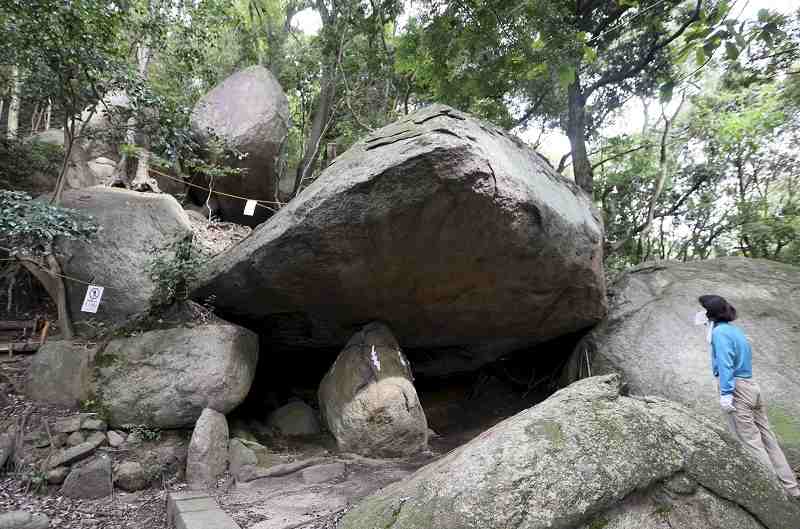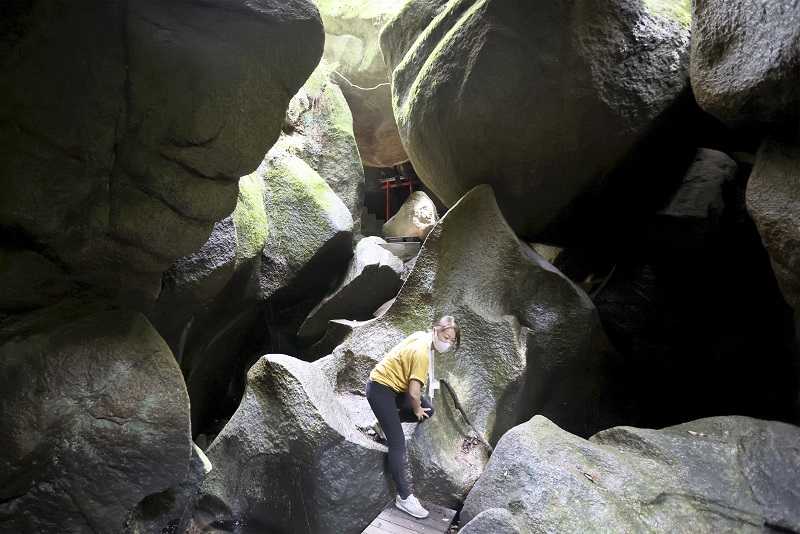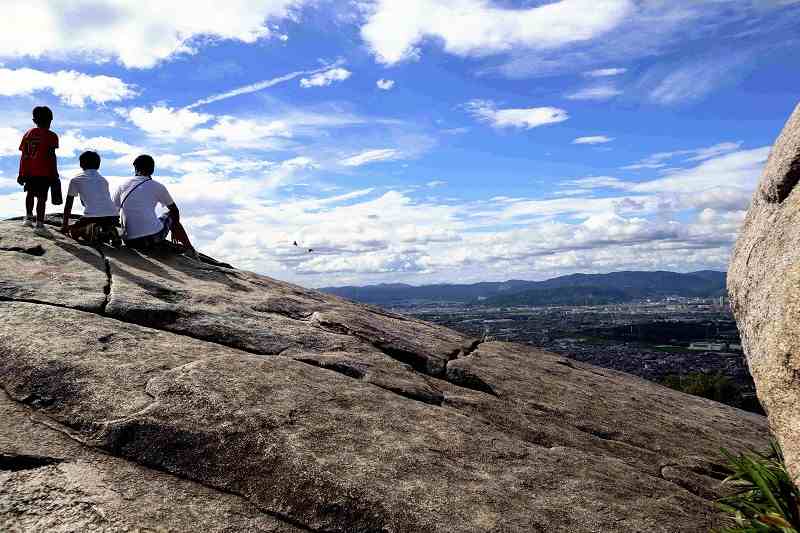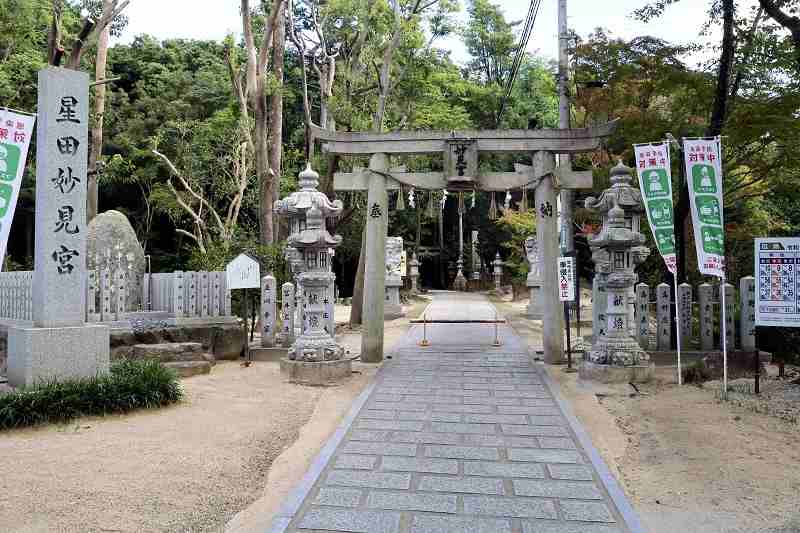
The rock cave at Shishikutsu Temple, the entrance of which looks like the mouth of a howling lion
17:34 JST, October 9, 2021
KATANO, Osaka — Overwhelmed by the imposing presence of the giant granite boulders, even I contemplated the mysteries of nature from seeing them. The groups of rocks in the southeastern mountainous area in Katano, Osaka Prefecture, have long been natural objects of worship.
Long ago, the area was a famous site for Shugendo, ascetic practices that are a fusion of mountain worship and Buddhism. Kobo Daishi (also known as Kukai), one of the most famous Buddhist monks in Japan, is said to have visited the area to practice asceticism.
It has been popular in recent years among hikers as a spiritual power spot.
Rock boat mythology

A tour inside a rock formation at Iwafune Shrine features a walk through narrow gaps between boulders. (This photo was taken with special permission).
I proceeded step by step on the rugged rocks, careful not to fall. While slipping through narrow gaps between the boulders, I groped my way along dark, steep slopes until sunlight guided my way to the exit.
The tour inside the rock formation at the Iwafune Shrine takes about 30 minutes. The shrine is dedicated to Ame-no-Iwafune, a 12-meter-high, boat-shaped boulder. Mythology says a deity named Nigihayahi rode the boat. The meaning of “Iwafune” is rock boat.
The area once flourished as a sacred site for Shugendo, and the rock formation at the shrine has been a training place of Shintoism and Shugendo worshippers since ancient times. The shrine was not open to the public until the 20th century.
It is said visitors can simulate the pain of being born through the birth canal by slipping through the gaps between the boulders.
“Visitors can be reborn and bring good luck to themselves,” said Akihiko Nishikado, head priest of the shrine. About 8,000 people a year visited the shrine before the pandemic, he said.

A panoramic view of Katano from atop Kannon Iwa rock
Magma related ‘accident’
More than half of the city’s area is occupied by the Ikoma mountains, including the boulder area. The mountains are believed to have been formed by crustal movements. Granite was formed deep underground through the slow cooling and solidification of magma before likely being lifted to the surface 1 to 2 million years ago. Most of that granite was eroded by rain and wind and turned into soil, but many boulders remained in Katano.
“We’ve no idea why so many rocks have remained,” said Tomofumi Yoshida, 41, a staff member of the city’s board of education. “We can only say it is an accident.”
Even rocks several meters high can be seen all over the mountains.
The mystery of nature must have attracted people to the area long ago.
Shishikutsu Temple (literally “Lion Cave Temple”) lies 2.5 kilometers north of Iwafune Shrine. The temple boasts a rock cave where Kukai is said to have practiced asceticism. The entrance to the cave does indeed remind me of a lion’s howling mouth.
Farther to the north lies Mt. Kono. Kannon Iwa rock stands atop the 341-meter-high mountain with a Sanskrit inscription meaning “holy Kannon.” It is believed to have been carved by an ascetic during the Edo period (1603-1867), proof the area was used as a place for worship.
Visitors can enjoy a panoramic view of Mt. Rokko and Kyoto from the top of Kannon Iwa, which is nearly 20 meters high.
A 40-year-old man who visited the site from Kyoto Prefecture with his two elementary-school-age sons looked refreshed.
“Here, we can enjoy the fresh air as much as we want without worrying about social distancing,” he said.
Nightscape from Kannon Iwa rock
Locals are working to use the boulders to attract tourists.
In March 2019, the Katano Tourist Association and others created a free guidebook in English and Japanese that provides information on where to find boulders in the city.
The Katano Tourism Promotion Council introduces hiking courses that include boulders on its website. Before the pandemic, the organization had held events featuring the nightscape from Kannon Iwa rock.
“It is close from central Osaka, so it’s a great place for hiking,” said Kenichi Matsuo, a staff member of the council’s secretariat. “I believe you can get power from the boulders and beautiful scenery.”
The boulders, representing nature in all of its majesty, will continue to empower the minds and bodies of visitors.
— Extend your trip!

Hoshida Myoken Shrine
Hoshida Myoken Shrine
Legend has it that 1,200 years ago, when Kukai chanted a secret Buddhist dharma in the cave at Shishikutsu Temple, the Big Dipper split apart and fell. The shrine is said to be one of the three places where the parts of the constellation fell from the sky. It is dedicated to Yogo Stone, said to have descended from heaven. The stone is also called Tanabata Stone. There are also many places with names related to stars in the area around the shrine, such as Amano River (or Amanogawa) — the Milky Way in Japanese.
— How to get there
Iwafune Shrine is an about 50-minute walk from Keihan Railway’s Kisaichi Station. Participants in the rock formation tour are required to be briefed in advance for safety reasons. Only groups of two or more who are 10 to under 75 are accepted. There is an entrance fee. Tour is not available at night or on rainy days. Shishikutsu Temple is an about 40-minute walk from the station, or from JR Kawachi Iwafune Station. Kannon Iwa rock is an about two-hour walk from JR Tsuda Station. All the routes are popular hiking courses.

A map of the southeastern mountainous area in Katano, Osaka Prefecture.
"Society" POPULAR ARTICLE
-

M4.9 Earthquake Hits Tokyo, Neighboring Prefectures
-

Israeli Tourists Refused Accommodation at Hotel in Japan’s Nagano Pref., Prompting Protest by Israeli Embassy and Probe by Prefecture
-

M7.5 Earthquake Hits Northern Japan; Tsunami Waves Observed in Hokkaido, Aomori and Iwate Prefectures
-

Tsukiji Market Urges Tourists to Avoid Visiting in Year-End
-

M5.7 Earthquake Hits Japan’s Kumamoto Pref., Measuring Upper 5 Intensity, No Tsunami Expected
JN ACCESS RANKING
-

Tokyo Economic Security Forum to Hold Inaugural Meeting Amid Tense Global Environment
-

Keidanren Chairman Yoshinobu Tsutsui Visits Kashiwazaki-Kariwa Nuclear Power Plant; Inspects New Emergency Safety System
-

Imports of Rare Earths from China Facing Delays, May Be Caused by Deterioration of Japan-China Relations
-

University of Tokyo Professor Discusses Japanese Economic Security in Interview Ahead of Forum
-

Japan Pulls out of Vietnam Nuclear Project, Complicating Hanoi’s Power Plans






















